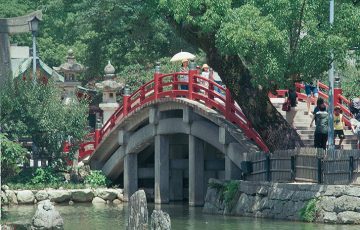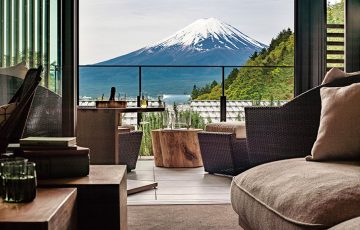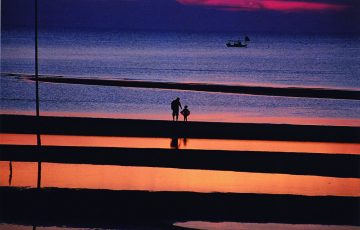 “…from her balcony she looked down on the city of Kobe. Michiko’s house was built on a hill. It looked over the town to the port with its cranes and the smoking chimneys of a steel works. Beyond this jumble was the sea…. She was far from the rice fields of memory here.”
“…from her balcony she looked down on the city of Kobe. Michiko’s house was built on a hill. It looked over the town to the port with its cranes and the smoking chimneys of a steel works. Beyond this jumble was the sea…. She was far from the rice fields of memory here.”
Michiko’s House, Meira Chand
You won’t find many rice fields in Kobe, a narrow strip of sea-facing land that was long ago requisitioned for modeling as a port, with all the adjuncts of quays, customs houses, stone esplanades, and warehouses that the word conjures up.
Kobe’s pre-foreign-settlement period is patchy. Korean emissaries knew the bay as Muko, Sung Chinese traders as Ogawa; the puppet emperor Antoku briefly moved the capital here from Kyoto. Its Spartan tidal flats did have a few rustic shrines, which were collectively known as Kan-be, or Ko-be, ‘God’s Door.’ Western captains elected to make Kobe a working port in 1868 as sounding surveys revealed that it had good land access and deep water. The new lifestyles that came with the expansion of the foreign community here were evident as early as 1871, when soccer and beef first appearedin the city. The first film was shown in the port in 1896, and Japan’s first golf course was laid out by a British designer in 1903.
 Kobe’s well-to-do foreign families chose the green pine covered hillside at the foot of Kitano Tenmangu shrine as their preferred residential zone. Among the foreign specialists who descended on Kobe was the British architect Alexander Nelson Hansell, who arrived in 1890 and spent 30 years in the city designing and building the resplendent houses, many of which still stand on the verdant slopes of Kitano.
Kobe’s well-to-do foreign families chose the green pine covered hillside at the foot of Kitano Tenmangu shrine as their preferred residential zone. Among the foreign specialists who descended on Kobe was the British architect Alexander Nelson Hansell, who arrived in 1890 and spent 30 years in the city designing and building the resplendent houses, many of which still stand on the verdant slopes of Kitano.
The houses, built mostly for prosperous traders and missionaries, are quite eclectic in style, reflecting the tastes of their owners and Hansell’s declared aim not to repeat himself. Persia House has decorated pediments in arabesques shaped from plastered wattle and daub; Hunter House is built from the best imported Southeast Asian hard woods; Weathercock House, completed in 1915, has domes that have been carved into cupola minarets. Other houses pay homage to Georgian, Moorish, Queen Anne, timbered Victorian and North American clapboard styles, while polygonal domes, columned porches, green wooden shutters and carved gables hint at a lifestyle far removed from Kobe’s dockside life of coolies and stevedores.
Many of these homes were lovingly restored after the Great Hanshin Earthquake, which struck the city in 1995, causing immense loss of life but also vast damage and destruction to private property. Although the psychological damage is inestimable and the city’s economy continues to suffer, the casual visitor to the city is unlikely to see any physical signs of the tragedy. Kobe is, in fact, a model of Japanese resilience and the ability to bounce back.
This is a city where foreigners have always felt comfortable. Author Nikos Kazantzakis wrote “I feel no remorse in this busy city of Kobe, because seeing and hearing while I ramble about the earth is my passion.” Lafcadio Hearn, relocating to the town in 1894 to edit the Kobe Chronicle, asserted that it was a “half return to Western life.” The wave of foreigners continued with Chinese, Koreans, and White and Jewish Russians and Turks, who have left an Orthodox Church, Jewish Center and Turkish-style Mosque. Though few of these families now remain, a more recent influx of Indians, Pakistanis and Bangladeshis have helped to maintain the international feel of the town. One of the newer, conspicuously South Asian buildings to have appeared is the 1986 Jain Temple, built from the very best imported white Indian marble.
 Kobe’s cultural eclecticism is reflected is its cuisine. While expensive, marbled cuts of Kobe beef may be the town’s signature food. Kobe boasts some of the best south Asian cuisine in Japan, fine French and Italian eateries, and a tasty line in fresh fish. Nankin-machi, Kobe’s small but electrifying Chinatown, has all the old-time Cantonese favorites along with a fascinating number of stalls selling snacks, tidbits, sweets, and tropical fruit drinks.
Kobe’s cultural eclecticism is reflected is its cuisine. While expensive, marbled cuts of Kobe beef may be the town’s signature food. Kobe boasts some of the best south Asian cuisine in Japan, fine French and Italian eateries, and a tasty line in fresh fish. Nankin-machi, Kobe’s small but electrifying Chinatown, has all the old-time Cantonese favorites along with a fascinating number of stalls selling snacks, tidbits, sweets, and tropical fruit drinks.
Being something less than 3km in length, Kobe is an easy city to negotiate on foot. Although Kobe has some sights worth checking out, such as its City Museum, a Maritime Museum, the pleasant Meriken Park, Kitano, Nankin-machi, the harbor area and Rokko Island, it is the city’s relaxed mood, the very atmospherics of the place that are most valued and commented upon.
Peel away the suppurating clutter, the shabby, post-war surface of construction that is often passed off as modernity, and there is at the center of most Japanese towns a historical kernel, a core essence waiting to be discovered. Finding such places is a quest of sorts, requiring patience – and a cultivated insensitivity to the eyesores that assault those who undertake these hopeful, largely rewarding searches. One such place with a traditional core that is not immediately apparent on arrival is Arima Onsen, an agreeable thirty-minute trip from Kobe. Arima sits on the north slope of Mount Rokko, in a green valley at the confluence of three rivers. First impressions, however, are not encouraging. Giant, ferro-concrete hotels resembling dam walls disfigure the surrounding hills; hotel touts assail passersby, and parking attendants bark at arriving tour buses.
But the history of Arima runs as deep as its water sources. Predating the founding of Nara as the capital in the 7th century, the spring has been delighting guests for well over a millennia. The spa enjoyed renewed popularity in the 17th century after Hideyoshi Toyotomi and his wife Nene began visiting in the company of the tea master Sen no Rikyu. Hideyoshi’s entourage of servants, ladies-in-waiting, bowmen, soothsayers and cooks would have reached the spring by a combination of ox cart and covered palanquin. In more recent times, the late novelist Tanizaki Junichiro enjoyed frequent visits to Arima’s older, more traditional inns.
Arima’s waters are divided into two types: the transparent ginsen, and kinsen, a rust-colored brew rich in iron. Promoted as an alleviation for neuralgia, skin problems, and ‘women’s disorders,’ Arima’s bucolic waters are said to be especially effective for gastrointestinal diseases. For day visitors, the tourist office recommends a soak at Arima Onsen Kaikan, the public bath near the station terminus, a haunt of pensioners seeking relief from constipation and other chronic digestive system disorders. For a more scenic bathing experience, Kampo no Yado, in a shrine area ten minutes west of the station, provides a more appealing, hillside setting. The more traditional side of Arima can also be experienced in its cuisine. Tansan senbei, a low-calorie rice-cracker baked using the water from Arima’s cold spas, is a popular buy. At Keigetsu, a restaurant run by the Kosenkaku Inn, a more refined fare is served. The three set courses are vegetarian temple cuisine. The simplest of the three, called Hana, consists of no less than 16 separate dishes.
Arima’s older, hidden core can be found in the Onsen-ji district, an area strongly associated with Hideyoshi. The district’s premier shrine, Tosenjinga, is tucked into a cedar and plum grove that forms one side of the quarter. Two adjacent temples, Onsen-ji and Gokuraku-ji, are distinctive for sumptuous altars and the piles of salvaged Confucian roof pediments and Buddhist statuary that lay around their grounds, exuding an air of antiquity. Nene’s summer villa is also here, now serving as Nembutsu-ji, a rustic temple whose elegant Japanese garden has an ancient sal tree, much visited in June when its white blossoms fall onto a bed of surrounding moss.
A medina of winding lanes, old wooden houses and serpentine slopes like Negai-zaka and Tansan-zaka, the area has a number of interesting art and craft shops, specializing in the playful Arima doll brushes. The brush contains a concealed doll at one end which pops up when the pen is tilted for writing, a humorous souvenir created over a thousand years ago. The more serious craft of making Arima baskets likely dates back to the 16th century. The more costly baskets, the smoked and lacquered variety, are much coveted for their use in the tea ceremony and in flower arranging.
Embodying the spirit of Arima’s older quarter is the graceful Hotel Hanako Yado. The inn sits at the foot of the flight of steps leading to Tosenjinga. Well-to-do foreigners were regular visitors to the hotel before the war, coming up from the port settlement in nearby Kobe during the humid summer months. Like Simla and Ooty, fashionable British hill stations in India, or the French colonial retreats in Cambodia’s Cardamom Mountains, Arima seems to have offered a much needed respite from life in the humid lowlands, at least for those who could afford it
Story and photos by Stephen Mansfield
From J SELECT Magazine, May 2010















Recent Comments